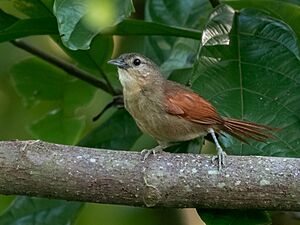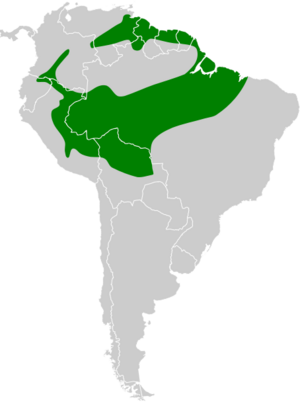Plain-crowned spinetail facts for kids
Quick facts for kids Plain-crowned spinetail |
|
|---|---|
 |
|
| Conservation status | |
| Scientific classification | |
| Genus: |
Synallaxis
|
| Species: |
gujanensis
|
 |
|
The plain-crowned spinetail (Synallaxis gujanensis) is a type of bird. It belongs to the ovenbird family called Furnariidae. You can find this bird in many South American countries. These include Bolivia, Brazil, Colombia, Ecuador, French Guiana, Guyana, Peru, Suriname, and Venezuela.
Contents
About the Plain-crowned Spinetail
The plain-crowned spinetail was first officially described in 1789. A German scientist named Johann Friedrich Gmelin gave it its scientific name. He based his description on notes and drawings from a French scientist, the Comte de Buffon. The name gujanensis comes from where the bird was first found, which was in the Guianas.
This bird is one of 37 types of spinetails in the Synallaxis group. This group was named in 1818 by Louis Pierre Vieillot.
Different Types of Plain-crowned Spinetails
Scientists recognize six different types, or subspecies, of the plain-crowned spinetail:
- S. g. columbiana
- S. g. gujanensis
- S. g. huallagae
- S. g. canipileus
- S. g. inornata
- S. g. certhiola
Some birds that were once thought to be plain-crowned spinetails are now considered separate species. These include the Araguaia spinetail, the white-lored spinetail, and the Maranon spinetail.
What Does the Plain-crowned Spinetail Look Like?
The plain-crowned spinetail is about 15 to 17 centimeters (6 to 7 inches) long. It weighs between 13 and 22 grams (about 0.5 to 0.8 ounces). Both male and female birds look the same.
The main type, S. g. gujanensis, has a grayish-brown face. It has a light grayish stripe above its eye. Its head and upper body are dull brownish. Its wings are a dark reddish-brown color. The tail is also dark reddish-brown and has pointy tips.
Its throat is whitish. The chest, sides, and under-tail feathers are brownish. Its belly is lighter than the rest of its underside. The bird's eyes are brown. Its beak is blackish on top and gray underneath. Its legs and feet can be olive-gray or greenish-yellow. Young birds have faint dark marks on their chest.
How Subspecies Differ
The different subspecies have slight variations in their colors:
- S. g. columbiana has whiter underparts and grayer sides.
- S. g. huallagae is darker and grayer, with olive-colored sides.
- S. g. canipileus is similar to huallagae but has grayer underparts and lighter wings and tail.
- S. g. inornata has richer brown upperparts and brighter rusty underparts.
- S. g. certhiola has a grayish face and a buffy white center on its belly. Its colors are in between the main type and inornata.
Where Do Plain-crowned Spinetails Live?
Plain-crowned spinetails live in many parts of South America. Each subspecies lives in a specific area:
- S. g. columbiana: South-central Colombia.
- S. g. gujanensis: Eastern and southern Venezuela, through the Guianas, and northern and eastern Brazil.
- S. g. huallagae: Southeastern Colombia, eastern Ecuador, eastern Peru, and northern Bolivia.
- S. g. canipileus: Southeastern Peru.
- S. g. inornata: West-central Brazil and northeastern Bolivia.
- S. g. certhiola: Eastern Bolivia.
These birds live in many different places, often near water. They can be found in gallery forest (forests along rivers), the edges of Várzea forest (floodplain forests), and secondary forest (forests that have grown back). They also like scrubby areas with tall cane plants and areas where trees like Cecropia grow on river islands. You might also see them in dense new growth in cleared areas or in plantations.
They usually live below 1,200 meters (about 3,900 feet) in elevation. In some areas, like Colombia, they are found below 1,000 meters (3,300 feet). In Ecuador, they are found below 400 meters (1,300 feet).
Plain-crowned Spinetail Behavior
Movement
The plain-crowned spinetail stays in the same area all year round. It does not migrate.
Feeding Habits
This bird eats arthropods, which are creatures like insects and spiders. It usually hunts in pairs. They look for food on the ground and in the lower parts of plants, up to about 2 meters (6.5 feet) high. They pick their prey from leaf litter, grass, and small branches.
Reproduction and Life Cycle
The plain-crowned spinetail's breeding season changes depending on where they live. In Suriname, eggs have been found in many months throughout the year.
Their nest is shaped like a globe and is made of sticks. It can be twice as long as it is wide. It has a horizontal tunnel that leads to the egg chamber inside. Nests are usually placed in thick plants, about 1 to 2 meters (3 to 6.5 feet) above the ground. A female bird usually lays two or three eggs. Scientists do not yet know how long the eggs take to hatch or how long it takes for the young birds to leave the nest.
Vocalization
The song of the plain-crowned spinetail sounds different in various places.
- In northeastern Brazil, it sounds like "Whip wuh". The first note is high and sharp, and the second is lower.
- In western Brazil, it sounds like "tjuh mcweet". The "weet" part is much higher.
- In Ecuador, the song is described as a slow "keé, kuh" that is repeated every few seconds.
Conservation Status
The IUCN (International Union for Conservation of Nature) has listed the plain-crowned spinetail as a species of "Least Concern". This means it is not currently threatened with extinction. It lives in a very large area, and its population size is believed to be stable. There are no immediate dangers that scientists have found. It is considered common in most places where it lives, though it can be harder to find in Colombia and Venezuela.


